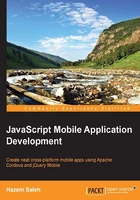
What this book covers
Chapter 1, An Introduction to Apache Cordova, teaches you what Apache Cordova is and the differences between mobile web, mobile hybrid, and mobile native applications. You will also know why we should use Apache Cordova, along with the current Apache Cordova architecture, and finally, the chapter offers an overview of the Apache Cordova APIs.
Chapter 2, Developing Your First Cordova Application, explains how to develop, build, and deploy your first Sound Recorder mobile application on the Android platform.
Chapter 3, Apache Cordova Development Tools, explains how to configure your Android, iOS, and Windows Phone development environments. You will also learn how to support and run your Sound Recorder mobile application on both iOS and Windows Phone 8 platforms.
Chapter 4, Cordova API in Action, dives deep into the Apache Cordova API, and you will see it in action. You will learn how to work with the Cordova accelerometer, camera, compass, connection, contacts, device, geolocation, globalization, and InAppBrowser APIs by exploring the code of the Cordova Exhibition app. The Cordova Exhibition app is designed and developed to show complete usage examples of the Apache Cordova core plugins. The Cordova Exhibition app supports Android, iOS, and Windows Phone 8.
Chapter 5, Diving Deeper into the Cordova API, continues to dive into the Apache Cordova API by exploring the remaining main features of the Cordova Exhibition app. You will learn how to work with the Cordova media, file, capture, notification, and storage APIs. You will also learn how to utilize the Apache Cordova events in your Cordova mobile app.
Chapter 6, Developing Custom Cordova Plugins, dives deep into Apache Cordova and lets you create your own custom Apache Cordova plugin on the three most popular mobile platforms: Android, which uses the Java programming language, iOS, which uses the Objective-C programming language, and Windows Phone 8, which uses the C# programming language.
Chapter 7, Unit Testing the Cordova App's Logic, explains how to develop JavaScript unit tests for your Cordova app logic. You will learn the basics of the Jasmine JavaScript unit testing framework and understand how to use Jasmine in order to test both the synchronous and asynchronous JavaScript code. You will learn how to utilize Karma as a powerful JavaScript test runner in order to automate the running of your developed Jasmine tests. You will also learn how to generate the test and code coverage reports from your developed tests. Finally, you will learn how to fully automate your JavaScript tests by integrating your developed tests with Continuous Integration tools.
Chapter 8, Applying it All – the Mega App, explores how to design and develop a complete app (Mega App) using the Apache Cordova and jQuery Mobile APIs. Mega App is a memo utility that allows users to create, save, and view audible and visual memos on the three most popular mobile platforms (Android, iOS, and Windows Phone 8). In order to create this utility, Mega App uses jQuery Mobile to build the user interface and Apache Cordova to access the device information, camera, audio (microphone and speaker), and filesystem. In this chapter, you will learn how to create a portable app that respects the differences between Android, iOS, and Windows Phone 8.